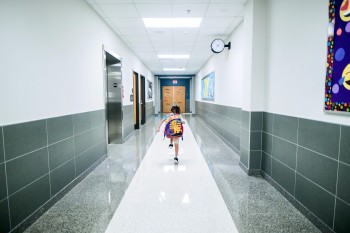One in five U.S. students attends K-12 school in a rural district. The reduced economies of scale in those schools can result in limited funding, barriers to on-going professional training for teachers and other factors that implicate trickle-down impacts on student experiences. However, many schools are developing creative solutions to address their needs, relying on technology and innovative solutions. In a manner reminiscent of a bookmobile, these approaches conquer distance and geographic isolation by bringing resources directly into the home community - except that instead of rolling in on four wheels in a converted truck, they are delivered by high-speed broadband connections.
The role of broadband in enabling distance education, particularly for convening geographically dispersed students for experiences that might otherwise be unavailable due to limited demand in individual schools or districts, remains an important application. Other approaches rely on that same technology for professional development, while robotics are now being explored to create “telepresence” experiences that enable distant teachers to interact with students in a manner closer to an in-person experience than a standard synchronous video interaction. A 2,400-student district in Kodiak, Alaska, employs these tools to serve students over a land area that is larger than Connecticut. A robot can roam hallways and classrooms and enables one-to-one student/teacher interaction. Before anyone wonders whether HAL 9000 is taking over the school, the robot includes a tablet-type screen that allows geographically distant administrators or specialists to obtain a better, more contextual understanding of the school environment while engaging individual interactions.
Rural teachers also report interests in exposing students to career paths that extend beyond opportunities their students might see locally. The growing popularity of teleworking allows students to explore those broader opportunities while not feeling compelled to leave their community to live elsewhere. Advanced connectivity also enables interactions among students and representatives from various industries who can serve as mentors or host virtual job fairs.
The model of partnership in education – students, school, home – also benefits from technology. While students obtain advantages from remote instruction, teachers can use similar platforms to participate in training and professional development. This is especially valuable in rural areas where broadband-enabled access resolves the need to add-on travel time to conferences or conventions. Discovery Education Network (which worked with NTCA’s Smart Rural Community program several years ago to demo remote learning experiences) is but one example of an organization using technology to provide comprehensive training and resources for educators.
For rural areas, these and other benefits can help address disparities that many rural students face. In the first instance, rural students often have fewer “opportunities to learn” (OTL) STEM subjects than urban peers. These divisions at the middle and high-school level can have follow-on impacts for post-secondary education and, ultimately, long-term career choices. While the number of rural students obtaining associates or bachelor's degrees is increasing, the averages currently trend about 14 percentage points lower than urban areas. To be sure, there is a prevailing and important conversation about the need to bring more students into CTE (career and technology education), and to not simply acknowledge but to effectively celebrate how technology is increasingly integral to manufacturing and agricultural careers; in short, to set aside the stigma that in too many instances was historically attached to “shop classes” and to instead recognize that the increasing incorporation of technology across sectors requires across-the-board upskilling (for a broader discussion, see this Smart Rural Community report on next-generation jobs). And that, I think, leads into a distinct advantage that rural schools enjoy: The ability to know each student and identify current and potential opportunities in the community for both typical and differentiated learners. And, it’s not just me: A March 2024 report from Jobs for the Future notes “Tight-knit, collaborative rural communities have an advantage over large cities, which often struggle with siloed or disjointed programming across K-12, higher education and workforce development.”
About two weeks ago, I went to an Indianapolis Indians game (AAA affiliate of the Pittsburgh Pirates) where the stadium concourse was lined with reps from everything from sheet metal cutters to pipe fitters to museums and everything in between – essentially a job fair at the ballpark that did a fantastic job exposing students to trades and other careers. And that is where school tech can play a similar role, overcoming the otherwise limited economies of scale to expose students to diverse opportunities and enable both student and teacher engagement with resources that might otherwise be unavailable. Both bode well for future educational and workforce opportunities in rural spaces.


